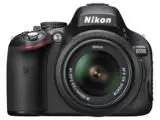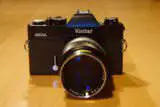Mit Spiegelreflexkameras können erfahrene Fotografen die Objektive wechseln und das richtige Objektiv für die jeweilige Aufnahmesituation auswählen. DSLR bezieht sich auf Spiegelreflexkameras, die digitale Fotos aufnehmen, und die wenigen Kameras, die noch auf dem Markt sind und noch Filme verwenden, werden einfach als Spiegelreflexkameras bezeichnet.
DSLR-Kameras eignen sich hervorragend für angehende Fotografen, da sie eine Live-Vorschau bieten und keinen Film verschwenden, wenn Fotografen Fehler machen. Es gibt mehr DSLRs auf dem Markt, daher sind sie tendenziell billiger. Film-Spiegelreflexkameras hingegen bieten eine etwas bessere Qualität von Farbe, Ton und Kontrast.
Contents
Vergleichstabelle
| DSLR | SLR Camera | |
|---|---|---|
 |
 |
|
| Technology | Digital single-lens reflex. Reflex mirror that allows live and digital optical viewing through the lens taking the image. | Single-lens reflex. Reflex mirror that allows live optical viewing through the lens taking the image. |
| Requires | Memory cards | Camera film |
| Storage | Thousands of images | 36 images per roll of film |
| Shutter Speed | 1 – 1/4000 s | 1-1/1000 s |
| Optical Viewfinder | Yes | Yes |
| Manual Controls | Yes | Yes |
| Lenses | Interchangeable | Interchangeable |
| Reusability | Images can be erased; card can be reused for a new set of pictures | Images cannot be erased, and the film cannot be reused |
| Video Capture | Sometimes | No |
| Live Preview | Sometimes | No |
Technology
DSLR and SLR cameras both reflect light that enters through the lens using a mirror so that an image can be seen in a viewfinder. However, an SLR camera uses a film made of plastic, gelatin and other material to record the image – a DSLR captures the image digitally, on a memory card.
This comprehensive video explains the difference between DSLR and SLR cameras very well:
<iframe width=”640″ height=”360″ frameborder=”0″ allowfullscreen src=”https://www.youtube.com/embed/EHj0JAZmSY8?iv_load_policy=3&rel=0&start=7″></iframe>
Required Materials and Processing

Memory cards used in a DSLR camera
A DSLR requires a flat memory card to store all its images in digital format. This little card can store thousands of images, and the user is able to delete any unwanted images instantly to make space for more. The card is reusable and the image can be seen instantly on camera or a computer, and can be printed right away with an external printer.
An SLR requires a roll of film usually made of a plastic strip lined with thin layers of gelatin containing silver halide crystals, which react chemically to light to form a photographic image. This chemical reaction needs to take place in a photo lab and requires a few hours to print. The film is not reusable, and can hold only upto 36 photos.

Film used in the SLR camera
Picture Quality
Both DSLRs and SLRs allow the photographer to view and focus the image using the attached lens. The first DSLRs had poorer picture quality than film SLRs. Advances in digital technology , including the number of megapixels available, have almost completely erased this difference.
Speed
Shutter speed depends on the type of DSLR or SLR. Entry level SLRs typically have a speed of 1 to 1/1000th of a second; the Konica Autoreflex TC has a shutter speed of 1/8 to 1/1000. Most modern DSLRs have shutter speeds up to 1/4000th of a second, much as high end ones can have shutter speeds as high as 1/8000 and above.
Optical Viewfinder
Both DSLR and SLR cameras use optical viewfinders to take pictures. DSLRs can also come with LCD viewfinders, like in point-and-shoot digital cameras, which is handy for situations when an optical viewfinder cannot be used, say underwater photography.
Complexity
Both DSLR and SLR cameras are similar in that they have several settings that the photographer controls, and can be difficult for beginners to use. They also require maintenance in keeping the lens and sensor clean and dust-free. DSLRs are more beginner-friendly as they allow the photographer to preview the image or take multiple images without wasting film. They also typically come with some in-built settings for different scenarios, and the user can switch to the LCD viewfinder if they wish.
Price
On Amazon.com, DSLR cameras range from about $500 to several thousand dollars, depending on the quality. There are far less film SLR cameras available, and the cost ranges from under $100 for a second-hand basic camera to around $1000. However, SLR cameras have the added cost of film rolls.
Other Pros and Cons
DSLRs allow photographers to store thousands of pictures on a memory card, while a roll of film in an SLR camera can only hold about 36 photographs. DSLRs also allow the photographer to preview the image after it has been taken, and make it easy to upload the photo to a computer to edit or print.
Why some photographers still choose film over digital
In an article for the BBC , analog photographer Stephen Dowling writes about why some photographers even in this day and age choose film over the more convenient digital photography option:
Some [photographers] may want to work with much larger formats (their digital equivalents can be very expensive), while others may prefer the look of film’s grain, or the less saturated colours of certain films. Some want to be in control of the entire process, from the taking of the pictures to developing their photos in a darkroom and slowly seeing prints emerge under the red light – an alchemical process that still, somehow, seems like magic.
References
- Wikipedia: Digital single-lens reflex camera
- Wikipedia: Single-lens reflex camera
- Which 35mm SLR Film Camera Should I Buy? – Fotographiqa
- Understanding Shutter Speed – Photography Life
- 5 Things You Should Consider Before Getting a DSLR – Hongkiat.com
- The photographers who refuse to abandon traditional film cameras – BBC